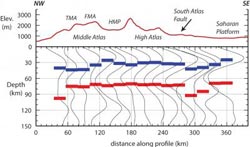Atlas Mountains in Morocco are buoyed up by superhot rock, study finds

This is a profile depicting the height and depth of the Atlas Mountains. The blue bars indicate the boundary between the crust and the superhot rock below, about 15 km shallower than predicted by previous models.<br><br>Credit: Figure 2 from the Geology paper, courtesy of Meghan Miller and Thorsten Becker<br>
In a new model, the researchers show that the mountains are floating on a layer of hot molten rock that flows beneath the region's lithosphere, perhaps all the way from the volcanic Canary Islands, just offshore northwestern Africa.
“Our findings confirm that mountain structures and their formation are far more complex than previously believed,” said lead author Meghan Miller, assistant professor of Earth sciences at the USC Dornsife College of Letters, Arts and Sciences.
The study, coauthored by Thorsten Becker, professor of Earth sciences at USC Dornsife, was published by Geology on Jan. 1, 2014 and highlighted by Nature Geoscience.
A well-established model for the Earth's lithosphere suggests that the height of the Earth's crust must be supported by a commensurate depth, much like how a tall iceberg doesn't simply float on the surface of the water but instead rests on a large submerged mass of ice. This property is known as “istostacy.”
“The Atlas Mountains are at present out of balance, likely due to a confluence of existing lithospheric strength anomalies and deep mantle dynamics,” Becker said.
Miller and Becker used seismometers to measure the thickness of the lithosphere – that is, the Earth's rigid outermost layer – beneath the Altas Mountains in Morocco. By analyzing 67 distant seismic events with 15 seismometers, the team was able to use the Earth's vibrations to “see” into the deep subsurface.
They found that the crust beneath the Atlas Mountains, which rise to an elevation of more than 4,000 meters, reaches a depth of only about 35 km – about 15 km shy of what the traditional model predicts.
“This study shows that deformation can be observed through the entire lithosphere and contributes to mountain building even far away from plate boundaries” Miller said.
Miller's lab is currently conducting further research into the timing and effects of the mountain building on other geological processes.
This research was funded by the National Science Foundation, grant EAR-0809023.
Media Contact
More Information:
http://www.usc.eduAll latest news from the category: Earth Sciences
Earth Sciences (also referred to as Geosciences), which deals with basic issues surrounding our planet, plays a vital role in the area of energy and raw materials supply.
Earth Sciences comprises subjects such as geology, geography, geological informatics, paleontology, mineralogy, petrography, crystallography, geophysics, geodesy, glaciology, cartography, photogrammetry, meteorology and seismology, early-warning systems, earthquake research and polar research.
Newest articles

Webb captures top of iconic horsehead nebula in unprecedented detail
NASA’s James Webb Space Telescope has captured the sharpest infrared images to date of a zoomed-in portion of one of the most distinctive objects in our skies, the Horsehead Nebula….

Cost-effective, high-capacity, and cyclable lithium-ion battery cathodes
Charge-recharge cycling of lithium-superrich iron oxide, a cost-effective and high-capacity cathode for new-generation lithium-ion batteries, can be greatly improved by doping with readily available mineral elements. The energy capacity and…

Novel genetic plant regeneration approach
…without the application of phytohormones. Researchers develop a novel plant regeneration approach by modulating the expression of genes that control plant cell differentiation. For ages now, plants have been the…





















